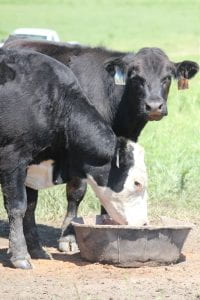Make plans to attend the 2nd annual Stock Growers Field Day on Tuesday, March 31, 2020. The event will be highlighted by beef reproduction economics and a market outlook along with an AI demonstration from industry and K-State Research and Extension experts in their field! The field day, held in Beloit, KS, is a collaboration with K-State Research and Extension and the Kansas Bull Test. Continue reading “Livestock Field Day to be held in North Central Kansas”
Category: March 2020
Evaluating Rules of Thumb for Grazing Management – Part 2
by Keith Harmoney, Range Scientist, Hays
Over the years, I’ve heard rangeland managers develop rules of thumb, or short phrases, to try to help them simplify decisions that need to be made to manage their pastures. Some of these rules of thumb have merit and scientific or economic data to support the rules of thumb; however, some rules of thumb may be unfounded and lack informational support. In the previous Beef Tips Newsletter, I listed some common rules of thumb, along with an explanation of whether or not the rule of thumb has any merit or basis of support. You can go back and read the first four Rules of Thumb in the January Beef Tips. This month, another four Rules of Thumb are listed, Continue reading “Evaluating Rules of Thumb for Grazing Management – Part 2”
Estrus Synchronization Planner Makes AI Planning Easier
By Sandy Johnson, Extension Beef Specialist, Colby
Increasingly producers are taking advantage of the benefits of artificial insemination (AI) made more successful and more convenient to apply with the current protocols available for synchronization of estrus and ovulation. Optimal reproductive performance relies on good year-round management. However, the best managed cows won’t respond if errors are made in implementing a synchronization system. A tool called the Estrus Synchronization Planner was designed to help producers correctly execute synchronization protocols to achieve the best possible response.
The Estrus Synchronization Planner is an Excel based program that steps users through protocol selection based on inputs of the type of cattle, amount of heat detection desired and the breeding date and time. Continue reading “Estrus Synchronization Planner Makes AI Planning Easier”
Beef Longissimus Lumborum Steak pH Affects External Bioelectrical Impedance Assessment
Objective: To use external bioelectrical impedance analysis to assess postmortem chemical changes in normal- and high-pH beef longissimus lumborum steaks during simulated retail display.
Study Description: Beef strip loins (n = 20; postmortem age = 14 d) obtained from a commercial processor were sorted into two treatments, normal-pH (5.61–5.64; n =11) and high-pH (6.2–7.0; n = 9). Loins were fabricated into five 1-inch thick steaks (n = 100), and randomly assigned to one of five display days: 1, 3, 5, 7, and 9. Continue reading “Beef Longissimus Lumborum Steak pH Affects External Bioelectrical Impedance Assessment”
Evaluating Stocker Steer Gains on Tallgrass Native Range with Two Burn Dates and Spices in Mineral
 Objective: The overall objective of this study was to evaluate management practices that may impact stocker steer gains on a 90-day double stocking grazing system in tallgrass native range. Specific objectives include evaluating the timing of burning, addition of spices in a complete free-choice mineral, and determination if the effects are additive.
Objective: The overall objective of this study was to evaluate management practices that may impact stocker steer gains on a 90-day double stocking grazing system in tallgrass native range. Specific objectives include evaluating the timing of burning, addition of spices in a complete free-choice mineral, and determination if the effects are additive.
Study Description: Two pasture burning times (March or April) and free-choice mineral with or without addition of spices were evaluated using 281 head of stocker steers on eight pastures of tallgrass native range. The spices included garlic oil in powder form and Solace (Wildcat Feeds LLC). Continue reading “Evaluating Stocker Steer Gains on Tallgrass Native Range with Two Burn Dates and Spices in Mineral”
Smartamine M Supplementation Reduces Inflammation but Does Not Affect Performance in Receiving Beef Heifers
Objective: This study was conducted to evaluate the ability of supplemental methionine to improve health, inflammation status, and performance of receiving cattle.
Study Description: A group of 384 crossbred heifers (initial weight 489 lb) of Tennessee origin were used in a 45-day receiving trial with limit-feeding to evaluate the effects of supplemental methionine (Smartamine M; Adisseo, Alpharetta, GA) on health, inflammation, and performance. Continue reading “Smartamine M Supplementation Reduces Inflammation but Does Not Affect Performance in Receiving Beef Heifers”
Sale Price of Holstein Feeder Steer Lots Relative to Other Breed Descriptions Sold Through Superior Livestock Video Sales from 2010 Through 2018
Objective: The objective of this study was to determine the relative value of Holstein feeder steer lots compared to steer lots of other breed descriptions sold through video auctions while adjusting for all other factors that significantly influenced sale price.
Study Description: Data were analyzed from 14,075 lots of feeder steers sold via 211 livestock video auctions from 2010 through 2018. Continue reading “Sale Price of Holstein Feeder Steer Lots Relative to Other Breed Descriptions Sold Through Superior Livestock Video Sales from 2010 Through 2018”
Effects of Limit Feeding Cold Stressed Growing Calves in the Morning Versus the Evening, as well as Bunk Line Sharing on Performance
Objective: To determine the response of cold stressed growing calves to being fed in the evening instead of morning hours, as well as the effect of bunk line sharing.
Study Description: Crossbred steers (n = 360) of Texas, Oklahoma, and Idaho origin were blocked by weight into four size groups and randomly assigned to pens, which were randomly allocated to one of five treatments. Continue reading “Effects of Limit Feeding Cold Stressed Growing Calves in the Morning Versus the Evening, as well as Bunk Line Sharing on Performance”